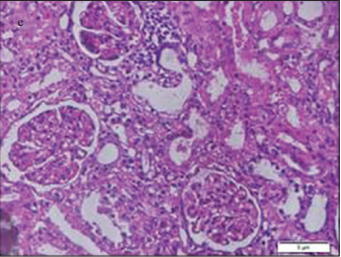Objective: The fibrotic process of kidney resulting in glomerulosclerosis was found in patients with ureteropelvic junction obstruction (UPJO) who underwent renal biopsy during pyeloplasty. Transforming growth factor β1 (TGF-β1) plays a role in collagen accumulation, resulting in fibrosis. Adipose tissue–derived stem cells (ADSCs) have an anti-apoptotic effect on target cells and enhance the kidney function recovery. We will further investigate the use of ADSC in the prevention of kidney fibrosis in the unilateral UPJO model of Wistar rats.
Material and methods: A total of twenty-two 12-week-old Wistar rats were divided into three groups. We made the UPJO models using nylon 6-0 inside the left ureter and tied the ureter with nylon 6-0, creating partial ureteral obstruction. The treatment group was then injected with 1.0 × 106 cells of human ADSC via the tail vein of rats. All rats were euthanized after 2 and 4 weeks of treatment. The left kidney used hematoxylin–eosin for histopathological examination. Statistical analysis using one-way analysis of variance (ANOVA) was done with SPSS version 21.0.
Results: TGF-β1 concentration in the treatment group was significantly lower in the 4th week of observation (p4=0.0001), as well as collagen type 1, which was also significantly lower in the 4th week (p4=0.0001). There was a significant difference in the glomerulus count between the control group and the human ADSC (hADSC) group therapy in week 2 and week 4 (p2=0.0001 and p4=0.026).
Conclusion: Administration of hADSC therapy reduces TGF-β1 and collagen type 1 levels and then improves the histopathological features in the process of renal fibrosis in the UPJO model.
Cite this article as: Siregar S, Noegroho BS, Karim MI. The effect of intravenous human adipose–derived stem cells (hADSC) on transforming growth factor β1 (TGF-β1), collagen type 1, and kidney histopathological features in the unilateral ureteropelvic junction obstruction model of wistar rats. Turk J Urol 2020; 46(3): 236-42.

.png)


.png)
